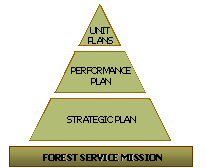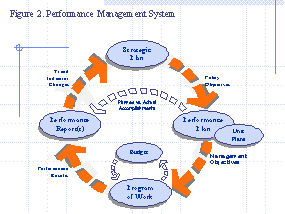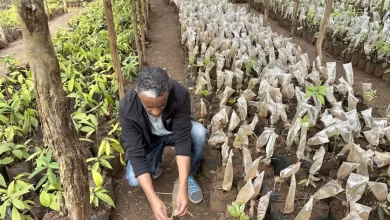using criteria and indicators in the United States of America

0939-B4
Elisabeth Grinspoon, Mark Delfs and Paul Brouha 1
Abstract
The United States of America, along with 150 nations, is employing criteria and indicators to assess forest conditions. Employing criteria and indicators to assess conditions, however, is not enough to effectively influence policies and decisions to achieve sustainable resource management. Countries must further integrate criteria and indicators into national forest programs.
The United States Department of Agriculture Forest Service is a pioneer in incorporating criteria and indicators into its programs. Among its initial efforts is the adaptation of a criteria and indictors framework to notional strategic plans, which are the primary vehicle for setting the course to achieve the Forest Service mission of sustaining the nation’s forests and grasslands for present and future generations.
This paper describes the steps the Forest Service is taking to adopt a framework, derived from the Montreal Process Criteria and Indictors, to its strategic plan. The analysis also describes challenges that the agency is encountering in adopting the framework, including gaps and inconsistent methodologies in resource assessments.
Despite these challenges, the application of a criteria and indicators framework is strengthening the capacity of the Forest Service to achieve sustainable resource management in at least three ways. First, the framework provides stakeholders with accepted sustainability indicators analogous to national economic indicators. These indicators offer a common vocabulary for effective collaboration among stakeholders with varying perceptions. Second, adaptation of a criteria and indicators framework to Forest Service strategic plans aligns long-range goals with measurable objectives. Alignment of goals and objectives enhances the agency’s capacity to focus scarce resources on activities that efficiently advance its mission. Third, adapting the framework to strategic plans provides the agency with tools needed to measure progress toward desired outcomes. The agency then has the capacity to evaluate policies for improvement.
“To sustain the health, diversity and productivity of the nation’s forests and grasslands to meet the needs of present and future generations.” – United States Department of Agriculture (USDA) Forest Service Mission Statement
Introduction
The mission of the USDA Forest Service is achieving sustainable resource management. The Forest Service is directly responsible for the sustainable management of 192 million acres of federal forests and grasslands in the National Forest System. The agency is also indirectly responsible for promoting the sustainable management of another one billion acres of publicly and privately owned forests and grasslands in the United States.

Figure 1. The Forest Service mission is the foundation for planning and program delivery at every level of the agency.
Essential to success of the Forest Service mission are long-term strategic plans, which communicate policy and guide the agency. Strategic planning provides guidelines for future agency actions by elucidating the agency’s mission, as well as strategic goals and objectives. These goals and objectives describe a specific course towards achieving the agency’s mission.
The strategic plan, however, does not specify what work the Forest Service will undertake. It does provide an explanation of why certain types of work are necessary and proposes appropriate programmatic strategies for undertaking the work. Execution of the agency’s strategic plan is the role of the Annual Performance Plan, which describes the annual program of work. Various unit plans, including the National Forest System’s Land and Resource Management Plans and the Research Work Unit Plans, also communicate objectives for annual programs of work at the local level (See Figure 1).
Strategic Planning History
When Congress established the Forest Service in 1905, it did not require that the agency write long-term plans. In the 1970s, controversy over forest service programs, such as clear-cutting on the national forests, increased. As a result, Congress instituted long-term planning requirements for the agency. Among these requirements, the Forest and Rangeland Renewable Resources Planning Act (RPA) of 1974 facilitates the process of assessing the status of renewable resources and the process of designing ways to meet present and future needs (Public Law 93-378). The RPA assessment and planning activities were designed to provide more scientific bases for management of the nation’s forests, to increase public participation in forest management, and thereby to reduce public contention over Forest Service programs.
Nearly twenty years after Congress first instituted long-term planning requirements, it passed the Government Performance and Results Act (Results Act) of 1993 mandating that each federal government agency prepare five-year strategic plans in consultation with Congress and with input from stakeholders. Eventually, Results Act strategic plans replaced RPA long-term plans as the means for establishing strategic direction for the Forest Service.
While the Results Act is similar to RPA, there are differences in language and purpose. An important change is the shift from output to outcome-oriented planning. While the RPA Program was output-oriented, the Results Act mandates outcome-oriented strategic plans. In other words, RPA focused on outputs, which are the products or yields resulting from direct consequences of management activities. The Results Act emphasizes outcomes, which are cumulative results of many activities directed toward common purposes.
Although the Results Act mandated outcome-oriented strategic plans, the agency’s initial long-term plan written under the Results Act, entitled the 1997 Strategic Plan, remained output-oriented and focused on management activities. In the 1997 Plan, each strategic goal was divided into several objectives with associated strategies, performance measures, and timeframes (GPRA Strategic Plan, 1997). For example, Goal 1 was: “Ensure sustainable ecosystems.” It was divided into four objectives: aquatic ecosystems, forested ecosystems, rangeland ecosystems, and hazardous substance sites. Under forested ecosystems, an objective was to restore 5-10% of National Forest System lands identified as needing restoration. Some of the strategies for achieving this goal included conducting research, taking inventories, and developing collaborative approaches.
The above example is representative of the 1997 Plan in that it had poorly defined indicators. Lack of baseline data also contributed to difficulty in demonstrating progress toward specific objectives and overall goals. To improve the strategic plan, the Forest Service began linking goals and objectives to science-based indicators of sustainability derived from the Montreal Process. Before describing how science-based indicators enhanced the strategic planning process, this paper outlines the Montreal Process and its implementation in the United States.
Montreal Process
The Montreal Process is an initiative among governments of non-European temperate and boreal forest countries to develop and implement internationally agreed criteria and indicators for sustainable management of forests. The notion of sustainability became popular in 1987 with the publication of Our Common Future, which defined sustainable development as: “development that meets the needs of the present without compromising the ability of future generations to meet their own needs” (Brundtland, 1987).
Sustainable development was the focus of the 1992 United Nations Conference on Environment and Development, known as the Earth Summit, which led to an agreement among world leaders on principles of sustainable forest management called the Statement of Forest Principles and Agenda 21 (Floyd, 2002). Although the broad definition of sustainability produced by the Bruntland Commission has been widely accepted, the precise meaning of sustainability was, and still is, widely debated. The debate focuses on the attributes of a sustainable forest.
In order to further delineate sustainable forests, Canada convened in Montreal an International Seminar of Experts on Sustainable Development of Boreal and Temperate Forests. After the Seminar, the Montreal Process Working Group met for the first time and stated its goal: “… to advance the development of internationally agreed upon criteria and indicators for the conservation and sustainable management of temporal and boreal forests at the national level.” In 1995, the Working Group issued the Santiago Declaration, named after the city in which group members endorsed the non-binding agreement on criteria and indicators for sustainable forest management. Twelve countries encompassing more than 90% of the world’s temperate and boreal forests endorsed the declaration (MPWG, 1999).
The Montreal Process framework does not propose management standards, rules, or regulations for managing sustainable forests. Instead, the framework offers a data collection tool and communication device in the form of indicators. Sustainability indicators are analogous to national economic indicators. Indicators provide a common vocabulary for participation and collaboration among stakeholders. Just as indicators of inflation and unemployment are indispensable in assessing the nation’s economic health, sustainability indicators are invaluable in tracking forest health and formulating analytically driven decisions regarding sustainability.
The Montreal Process framework is composed of seven criteria and 67 indicators, commonly known as the Montreal Process Criteria and Indicators (C&I). The Montreal Process Working Group defines criteria as categories of conditions or processes by which sustainable forest management may be assessed. Likewise, indicators are measures (measurements) of an aspect of a criterion. The seven criteria fall into three general categories: vital functions and attributes (biodiversity, productivity, forest health, the carbon cycle, and soil and water protection), socio-economic values and benefits (timber, recreation, and cultural values) and the laws and regulations that comprise the forest policy framework (MPWG, 1999).
On November 5, 1993, following the Earth Summit, the United States (U.S.) committed to a national goal of sustainable forest management through a presidential directive entitled Environmental Policy on International Desertification, Forest Conservation, and Fresh Water Security (Presidential Decision Directive/NSC-16).
The U.S. not only agreed to non-binding principles on forest conservation and sustainable use, the directive also stated that: “…we must take the lead internationally by observing these principles ourselves… The United States is committed to a national goal of achieving sustainable management of U.S. forests… Our national objectives are that: our nation’s forest should be healthy and productive; the growth of our timber should exceed harvest; and our forests should be reservoirs of biological diversity and carbon” (Presidential Decision Directive/NSC-16).
As part of U.S. efforts to achieve sustainability, in 1994, the Forest Service and the U.S. State Department organized a group of stakeholders to provide a forum for discussion of the Montreal Process Criteria and Indicators (C&I). The forum, officially chartered in 1999, is known as the Roundtable on Sustainable Forests. Although the Roundtable is not a decision-making body, it enables better decision-making through the sharing of information and perspectives among individuals representing diverse interests. More than 40 government and non-governmental organizations participate in the Roundtable including: federal government agencies; tribal, state, and local units of government; private landowners and citizens; industries and businesses; conservation and environmental groups; regional and community-based organizations; as well as researchers and academics.
Stakeholders have disparate ideas about how to achieve sustainability. To facilitate the resolution of these differences, Roundtable meetings are convened by a non-profit organization that specializes in solving problems related to the environment. The Roundtable meets regularly to discuss what C&I mean for forest management and conservation in the United States, how data for the indicators are collected, and who is responsible for acquiring the data. One of the biggest challenges for stakeholders has been reaching agreement on interpretation of specific indicators and means for evaluating them.
Building consensus is both a great challenge and benefit of the Roundtable. Finding ways for stakeholders with varying perspectives to communicate is especially important in a country as diverse as the United States with forestlands that are owned and managed by different private and public entities. Roundtable stakeholders use the C&I framework to resolve shared problems across multiple jurisdictions and tenure arrangements. In this way, the Roundtable and the C&I framework bring disparate parties together to build a consensus for achieving sustainable forestry. Because of the Roundtable’s success, similar sustainability roundtables have been established concerning rangeland resources, minerals, and water.
Roundtable work is divided between two groups: a Communications and Outreach Work Group and a Technical Work Group. The former has sponsored workshops to inform state, county and other government officials, practitioners, as well as the general public about sustainable forest management and the criteria and indicators. The latter has held workshops for technical experts to identify regional and national data sets and information gaps. Workgroup members found that nine of the 28 Montreal Process biological indicators have been part of Forest Service sampling for 70 years (Robin Maille, 2000).
The Technical Workshops initiated production of a national report based on criteria and indicators addressing an array of environmental, social, and economic concerns. The report describes the current status and conditions of US forests, including trends in their health, productivity and use. Federal participants in the Roundtable formed the Sustainable Forest Data Working Group and collaborated with a variety of state, nongovernmental, and private institutions to compile the extensive report, known as the National Report on Sustainable Forests, which is a reference point for measuring national progress toward sustainable resource management.
Strategic Planning and the Montreal Process
Forest Service Strategic Planning has benefited tremendously from the efforts of the Roundtable on Sustainable Forests and the Montreal Process. In the year 2000, the Forest Service published a revision of the strategic plan with linkages to the Montreal Process framework.
Comparing the strategic goals in the 2000 Strategic Plan Revision with the core principles of the Montreal Process shows an overlap between them. The four goals of the strategic plan and the three core Montreal Process Principles cover the social, ecological and economic values of sustainability (John Day, 2000). The three Montreal Process Principles are: maintenance of ecosystem integrity, social values related to the forest, and production of goods and services. Similarly, the four Forest Service strategic goals are: ecosystem health, effective public service, multiple benefits to people, and scientific and technical assistance.
The connections between the Montreal Process and the strategic plan are more substantial with respect to indicators and the objectives. The Montreal Process Indicators provide links between strategic objectives and results-focused outcome measures. An example is the best way to illustrate the linkages: Montreal Process Criterion 1 relates to the conservation of biological diversity. One of the indicators for this criterion is the status of forest-dependent species at risk of not maintaining viable breeding populations. Goal 1 in the 2000 Revision is linked to Criterion 1. Goal 1 is the promotion of ecosystem health and conservation to sustain the Nation’s forests, grasslands, and watershed. One of the objectives associated with this goal is providing ecological conditions to sustain viable populations of native and desired non-native species. The measure for this objective is the status and/or trends in populations, habitats, and ecological conditions for selected species. Among the species tracked are the red-cockaded woodpecker and golden-winged warbler as representatives of the Long-leaf and short-leaf pine ecosystems in the Southeast.
Despite the linkages between the C&I and the 2000 Revision, measurement problems arose due to insufficient data. With respect to the example above, milestones set for meeting the objective were vague and data were not available for some indicator species. Another objective under Goal 1 concerning watershed health demonstrates similar problems with objectives in the 2000 Revision. The watershed health objective was designed to improve and protect watershed conditions. Progress toward the objective was not measurable because the Forest Service had not fully delineated watersheds and lacked a comprehensive monitoring protocol and program to assess watershed condition and function. Baseline data were also lacking for other long-term measures and milestones in the 2000 Strategic Plan Revision. This paucity of reliable baseline data left the agency incapable of credibly demonstrating accountability for the expected long-term results.
The 2000 Revision suffered from additional problems similar to its predecessor. Like the 1997 Strategic Plan, the 2000 Revision did not drive performance of agency programs because annual budget development and allocation remained independent of strategic planning. The disjuncture between budgets and strategic plans further hindered the Forest Service ability to demonstrate accountability and progress toward its mission of sustainable forest management.
2003 Strategic Plan Update
In order to redress these performance accountability problems, the Strategic Planning and Resource Assessment Staff is completing a 2003 Strategic Plan Update that strengthens linkages between science-based criteria and indicators derived from the Montreal Process C&I and agency’s strategic goals and objectives. The objectives set forth in the 2003 Update are largely based on contextual information from the National Report on Sustainable Forests and the 2000 RPA Assessment, both of which use C&I to assess status and trends in forest sustainability in terms of the ecological, social, and economic environment.
Although designers of the Montreal Process C&I framework warn that it should not be used as a performance yardstick to evaluate a nation’s forest management program, using the framework as a springboard for strategic planning assists the Forest Service in ensuring that it meets the varied aspects of sustainability and improves performance accountability. Adopting a C&I framework also provides an efficient means to communicate condition and trend information that forms a basis for forest policy dialogues. In other words, the C&I framework offers an effective vocabulary to engage stakeholders enabling them to work productively with different institutions and jurisdictions having mutual interests in sustainable forests. As Figure 2 demonstrates, trend indicators and policy objectives function as crucial links in the Forest Service

Performance Management System.
The 2003 Update has three goals, which are parallel to the three main categories of the Montreal Process Criteria. The goals are: maintain the health, productivity and diversity of the nation’s forests and grasslands; provide a sustainable flow of goods and services from the nation’s forests and grasslands; and, maintain the organizational capacity to provide effective public service.
In order to prepare objectives for the three goals, the Strategic Planning Staff sought to identify key indicators of sustainability from the full suite of 67 Montreal Process Indicators. Particularly useful were the twenty core indicators adopted from the C&I by the Northeast Area Association of State Foresters (NAASF), an organization that represents the directors of state forestry agencies in the northeastern U.S. The 20 indicators adopted by NAASF span the seven criteria of the Montreal Process framework. Each of the seven criteria is represented by one to three different indicators (Sourcebook on Criteria and Indicators, 2002). These indicators became the basis for drafting an initial set of measurable policy objectives that address a limited set of high-priority issues, which emerged from analysis of the 2000 RPA Assessment. As a result, policy objectives are linked to key social, economic, and ecological conditions. Taking a pragmatic approach, the staff made efforts to design measures to assess progress toward mission-critical objectives in order to have the capacity to demonstrate program effectiveness.
The mission-critical objectives reference the sustainability trend indicators upon which the objective is based. To determine if program management decisions and activities are advancing a particular policy objective, the Strategic Planning Staff refers to annual performance reports and to the RPA Assessment and National Report on Sustainable Forests for baseline and trend data. Additionally, the 2003 Update describes objectives in light of how it expects Forest Service programs to influence long-term trends. Potential interactions between various outcomes are also noted. These include adverse effects on carbon sequestration through controlled burns that aim to reduce hazardous fuels and improve forest health.
Conclusions
Strengthening the linkages between the Forest Service Strategic Plan and the Montreal Process C&I improves the agency’s capacity to achieve its mission of sustainable resource management in several ways. First, the Montreal Process framework provides stakeholders with accepted sustainability indicators analogous to national economic indicators. These indicators offer a common vocabulary for effective collaboration among stakeholders. Second, the framework focuses scarce resources on work directly related to accomplishment of the Forest Service mission of sustainable resource management. Third, the framework offers trend indicators. In conjunction with annual performance reports, trend indicators enable the Forest Service to track performance, which can then be measured and evaluated against the periodic RPA Assessments and other existing databases. Finally, these measured outcomes allow the Forest Service to demonstrate effectiveness in delivering its mission and to improve its capacity to achieve sustainable resource management in the future.
The United States is not alone in facing the challenge of sustainable resource management. Problems such as population growth, subdivision of open spaces, and wild land fires confront most of the 150 nations that are employing C&I to assess forest conditions. Employing C&I to assess conditions, however, is not enough to effectively influence policies and decisions to achieve sustainable resource management. Countries must further integrate C&I into their national forest programs. Like the United States, these countries are likely to benefit from the adaptation of C&I to strategic plans to meet the challenges of sustainable resource management.
Bibliography
Brundtland, G.H. 1987. Our Common Future: World Commission on Environment and Development. Oxford University Press.
Day, John. 2000. Opportunities to Use Criteria and Indicators In Evaluating the Achievements of the Forest Service Strategic Plan (2000 Revision). Forest Service Region 10.
Floyd, Donald W. 2002. Forest Sustainability: The History, the Challenge, the Promise. The Forest History Society, Durham, North Carolina.
Forest and Rangeland Renewable Resource Planning Act of 1974. Public Law 93-378. Approved August 17, 1974.
Government Performance and Results Act of 1993. Public Law 103-62. August 3, 1993.
Meadows, Donella. 1998. Indicators and information systems for sustainable development: a report to the Balaton Group. Hartland Four Corners, VT: The Sustainability Institute.
MPWG, Montreal Process Working Group. 1999. Criteria and indicators for the conservation and sustainable management of temperate and boreal forests. 2nd ed. [http://www.mpci.org/meetings/ci/ci_e.html].
MPWG, Montreal Process Working Group. 1999. Forests for the future: Montreal Process criteria and indicators. [http://www.mpci.org/].
Maille, Robin. 2000. USDA Forest Service International Programs Newsletter, “Sustainability Roundtable Buildings Partnerships, No. 5.
Presidential Decision Directive/NSC-16, Environmental Policy on International Desertification, Forest Conservation and Fresh Water Security, The White House, November 5, 1993.
USDA Forest Service 1997 GPRA Strategic Plan. [http://www.fs.fed.us/intro/gpra97.html]
USDA, Forest Service. 2000. USDA Forest Service Strategic Plan (2000 Revision), [http://www2.srs.fs.fed.us/strategicplan]
USDA Forest Service. Forthcoming. USDA Forest Service Strategic Plan (2003 Update). [http://www2.srs.fs.fed.us/strategicplan]
USDA Forest Service, 2001 RPA Assessment of Forest and Range Lands. FS-687. Washington, DC.
USDA Forest Service, State and Private Forestry, Northeast Area. 2002. Sourcebook on Criteria and Indicators of Forest Sustainability in the Northeastern Area. NA-TP-03-02.
U.S. Roundtable on Sustainable Forests. 2001. Roundtable on Sustainable Forests: criteria and indicators technical workshop results. [http://www.sustainableforests.net/C&I_workshops/ci_index.html]
1 USDA Forest Service, Mail Stop 1129, 1400 Independence Avenue, SW, Washington, DC 20250-1129, USA. [email protected],



